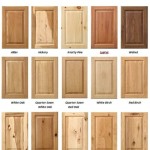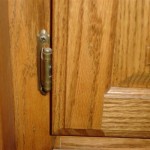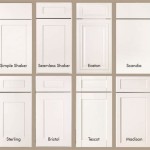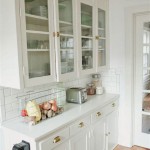How To Remove the Bottom of a Kitchen Sink Cabinet
Removing the bottom of a kitchen sink cabinet may be necessary for various reasons, including repairing water damage, replacing the flooring underneath, modifying the cabinet for plumbing access, or improving storage solutions. The process requires careful planning and execution to avoid damaging the cabinet structure or any existing plumbing and electrical systems.
Before commencing the removal process, it is essential to identify the type of cabinet construction and how the bottom panel is attached. Different cabinet manufacturers and installers employ various methods, such as screws, nails, glue, or a combination thereof. Understanding the attachment method will dictate the tools and techniques required for successful removal.
Safety is paramount. Turn off the water supply to the kitchen sink at the main shut-off valve or the nearest accessible shut-off. Disconnect any electrical appliances plugged into outlets within the cabinet area. Wear safety glasses to protect against debris and work gloves to protect hands during the removal process.
Preparation and Assessment
Begin by emptying the entire contents of the kitchen sink cabinet. Remove all cleaning supplies, dishes, and any other items stored within. This ensures a clear workspace and prevents accidental damage to personal belongings. Thoroughly inspect the cabinet's interior to identify all visible fasteners securing the bottom panel. Note the type of fasteners (screws, nails, staples) and their location.
Examine the surrounding cabinet structure to determine if the bottom panel is integral to the overall stability of the cabinet. Some cabinets rely on the bottom panel for structural support, while others are inherently stable due to the side and back panels. If the bottom panel appears crucial for structural integrity, consider implementing temporary bracing before removal. This can be achieved using wooden supports or adjustable metal poles positioned inside the cabinet to maintain its shape and prevent sagging or collapse.
Carefully inspect for plumbing and electrical lines running through or along the bottom of the cabinet. Water supply lines, drain pipes, and electrical wiring for garbage disposals or dishwashers may be routed through the cabinet's bottom panel. Identify the location and any potential interference before proceeding.
Gather the necessary tools. A selection of screwdrivers (Phillips head and flathead), a pry bar, a utility knife, a hammer, a reciprocating saw (also known as a Sawzall), and a drill or impact driver will likely be needed. A stud finder can be helpful to locate studs behind the cabinet, potentially indicating hidden fasteners. Safety glasses and work gloves are essential personal protective equipment. A shop vacuum is useful for cleaning up dust and debris during and after the removal process.
Removing the Bottom Panel: Different Attachment Methods
The removal process will vary depending on how the bottom panel is attached to the cabinet frame. Each attachment method requires a specific approach to minimize damage to the surrounding cabinet structure.
Screws:
If the bottom panel is secured with screws, use the appropriate screwdriver (Phillips head or flathead) to remove them. If the screws are stripped or difficult to remove, try using a screw extractor or a rubber band placed between the screwdriver and the screw head to improve grip. In cases of severely corroded screws, penetrating oil can be applied to loosen them before attempting removal.Nails:
If the bottom panel is attached with nails, use a pry bar and a hammer to carefully remove them. Place a thin piece of wood between the pry bar and the cabinet frame to protect the surrounding surface from damage. Gently pry the nails out, working around the perimeter of the bottom panel. If the nails are deeply embedded, a nail punch can be used to drive them further into the wood, allowing the panel to be removed without damaging the surrounding frame. Alternatively, use a reciprocating saw with a metal-cutting blade to cut the nails flush with the cabinet frame.Glue:
If the bottom panel is glued in place, use a utility knife to score along the edges of the panel where it meets the cabinet frame. This will help to break the glue bond. Then, use a pry bar and a hammer to carefully separate the panel from the frame. Apply gentle pressure and work around the perimeter of the panel, gradually loosening the glue. A heat gun can be used to soften the glue, making it easier to separate the panel. Be cautious when using a heat gun to avoid damaging the surrounding cabinet finish.Combination of Methods:
In some cases, the bottom panel may be attached using a combination of screws, nails, and glue. Address the screws and nails first, then use a utility knife and pry bar to loosen the glue. This may require a more methodical approach, working section by section to gradually detach the panel from the frame.If the bottom is a thin piece of plywood and appears to be stapled in, a heavy duty staple remover may be necessary, taking great care not to damage surrounding parts of the cabinet.
Addressing Potential Problems and Additional Considerations
During the removal process, several potential problems may arise. Addressing these issues promptly and effectively will minimize damage and ensure a successful outcome.
Water Damage:
If the bottom panel is severely water-damaged, it may be brittle and prone to crumbling. In this case, use a reciprocating saw with a wood-cutting blade to carefully cut out sections of the panel. This will prevent further damage to the surrounding cabinet frame. Wear a dust mask to protect against mold spores, which may be present in water-damaged materials.Plumbing and Electrical Obstructions:
If plumbing or electrical lines are obstructing the removal of the bottom panel, take extra precautions to avoid damaging them. Turn off the power at the breaker box before working near electrical wiring. Carefully maneuver the bottom panel around the pipes and wires, using a utility knife or reciprocating saw to create notches or cutouts as needed.Cabinet Frame Integrity:
If the removal of the bottom panel compromises the structural integrity of the cabinet, install temporary bracing to support the frame. This can be achieved using wooden supports or adjustable metal poles positioned inside the cabinet. Consider reinforcing the remaining cabinet structure with additional screws or glue to prevent sagging or collapse.Cleaning:
After the bottom panel has been removed, thoroughly clean the interior of the cabinet. Use a shop vacuum to remove dust and debris. Apply a disinfectant cleaner to sanitize the area and prevent mold growth. Inspect the underside of the sink and plumbing for any leaks or damage and make any necessary repairs.When the bottom of the cabinet is removed, there may be exposed edges of the side panels. These edges can be sharp or splintered, and should be addressed to prevent injury. Sanding the edges smooth with a fine grit sandpaper will help. Applying edge banding, which is a thin strip of material that is glued or ironed onto the edge, will also provide a clean and finished look, concealing the raw edge of the wood.
Before considering to reinstall the bottom cabinet, assess the area that now has access. If the reason for removing the bottom of the cabinet was to fix a water leak or to repair damage, ensure those projects are complete before moving forward.
If replacing the bottom of the cabinet is desired, measure the original panel and cut a new piece of plywood or other suitable material to the same dimensions. Consider any access holes for pipes or wires when cutting the new bottom. Use appropriate fasteners and adhesive to secure the new bottom panel to the cabinet frame. Seal any gaps with caulk to prevent water damage.
Proper planning, careful execution, and attention to detail are essential for successfully removing the bottom of a kitchen sink cabinet. Taking the time to assess the situation, gather the necessary tools, and address potential problems will minimize damage and ensure a satisfactory outcome. The replacement of the bottom of the cabinet must also be carefully planned, especially if the old cabinet bottom was critical for structural support.

How To Replace Under The Sink Cabinet Base

Replace Sink Cabinet Floor

How To Replace That Old Rotted Out Sink Base Floor Step By

Diy Replace Bottom Of Sink Cabinet Without Cutting Pipes Or Face

Replace Cabinet Floor Under Sink Diy

How To Replace A Rotten Cabinet Bottom

Kitchen Removing Base Cabinet Countertops Backsplash
:max_bytes(150000):strip_icc()/8_remove-sink-base-cabinet-56a4a26d3df78cf772835b30.jpg?strip=all)
How To Remove A Bathroom Vanity Cabinet

Repair Sink Cabinet Water Damage Rot

Repair Sink Cabinet Water Damage Rot
Related Posts








